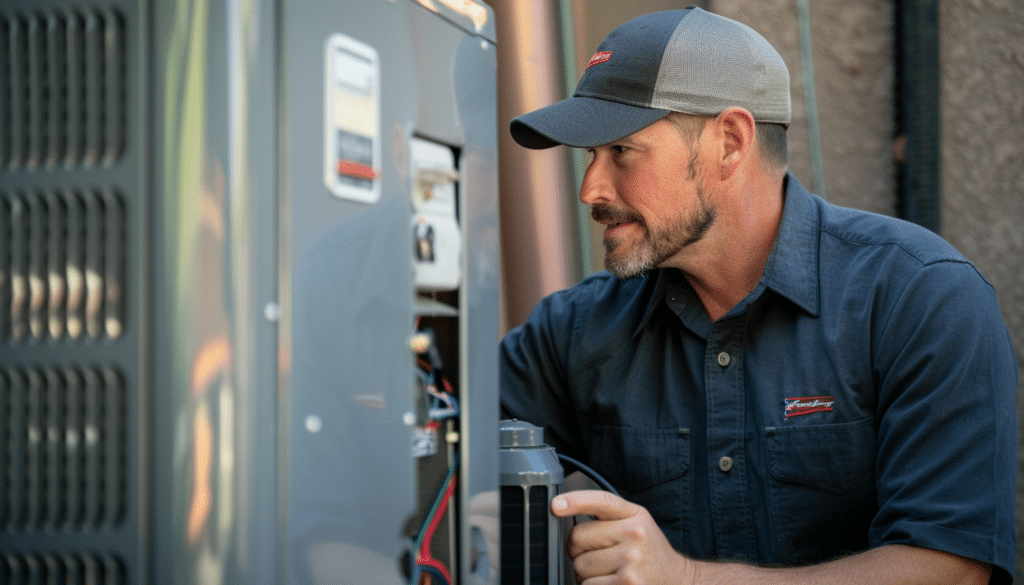No Heat? Troubleshooting HVAC Tips Inside
Experiencing an HVAC unit running without producing heat can be frustrating, especially during cold weather. Understanding the common issues and their solutions can help restore comfort in your home quickly. This blog will guide you through the most common problems and provide practical solutions to get your heating system back on track.
Understanding Your HVAC System
Before diving into troubleshooting HVAC, it’s essential to understand the basics of how your HVAC system works. HVAC stands for Heating, Ventilation, and Air Conditioning. The primary components of your system include the furnace, heat pump, thermostat, and various ducts and vents. Each part plays a crucial role in maintaining the desired indoor temperature.

Common Issues and Solutions
Let’s explore some typical problems that can cause your HVAC system to run but not produce heat, along with steps you can take to resolve these issues.
- Thermostat Issues
- Incorrect Settings: Ensure your thermostat is set to “heat” and the temperature setting is higher than the current room temperature.
- Dead Batteries: Replace the batteries in your thermostat if it’s battery-operated.
- Calibration Problems: If your thermostat is not calibrated correctly, it might not signal the furnace to start. Consult your user manual for calibration instructions.
- Pilot Light or Ignition Problems
- Pilot Light Out: For older systems with a pilot light, check if it’s out. Relight it according to the manufacturer’s instructions.
- Electronic Ignition Failure: Modern systems use electronic ignition systems. If this fails, you might need a professional to inspect and repair it.
- Clogged Filters
- Dirty Air Filters: A dirty filter can restrict airflow, causing the system to overheat and shut down as a safety measure. Replace filters regularly, ideally every 1-3 months.
- Fuel Supply Issues
- Gas Supply: Ensure the gas valve to your furnace is fully open. If you suspect a gas supply issue, contact your gas company.
- Oil Supply: If you use an oil furnace, check your oil levels and refill if necessary.
- Electrical Problems
- Tripped Breakers: Check your home’s breaker panel. If the breaker for your HVAC system has tripped, reset it.
- Blown Fuses: Inspect fuses in the furnace. Replace any blown fuses.
- Blocked Vents
- Closed or Blocked Vents: Ensure all supply and return vents are open and not obstructed by furniture or other items.
- Blower Motor Issues
- Blower Motor Not Running: If the blower motor is not working, it can’t circulate warm air. You might need a professional to repair or replace the motor.
- Ductwork Problems
- Leaky Ducts: Inspect ductwork for leaks. Seal any gaps with duct tape or mastic sealant.

Detailed Steps for Common Fixes
To make the troubleshooting HVAC process easier, here are some detailed steps for the most common fixes.
Replacing a Thermostat Battery
- Locate the Thermostat: Open the thermostat cover.
- Remove Old Batteries: Take out the old batteries.
- Insert New Batteries: Install new batteries, ensuring correct polarity.
- Reset Settings: Replace the cover and reset your thermostat settings if necessary.
Cleaning or Replacing Air Filters
- Turn Off the Power: Switch off your HVAC system.
- Locate the Filter: Find the air filter, usually near the return air duct or the furnace.
- Remove the Filter: Slide out the dirty filter.
- Inspect and Clean: If reusable, clean the filter with water and let it dry completely. If disposable, replace it with a new filter.
- Reinstall the Filter: Put the clean or new filter back in place.
- Power On: Turn the HVAC system back on.
Relighting a Pilot Light
- Turn Off the System: Switch off your HVAC system.
- Find the Pilot Light: Locate the pilot light assembly.
- Turn Off Gas: Turn the gas control valve to the “off” position and wait a few minutes.
- Light the Pilot: Turn the gas valve to the “pilot” position, hold down the reset button, and use a long lighter to ignite the pilot light.
- Hold and Release: Continue holding the reset button for 30-60 seconds, then release it.
- Turn On the System: Turn the gas valve back to the “on” position and switch on your HVAC system.
Preventive Measures to Avoid Future Issues
Maintaining your HVAC system can prevent many issues. Here are some preventive measures:
- Regular Maintenance: Schedule annual HVAC maintenance with a professional.
- Filter Replacement: Change air filters every 1-3 months.
- Inspect Components: Regularly check and clean components like the blower motor, pilot light, and ignition system.
- Seal Ducts: Ensure ductwork is properly sealed to prevent leaks.
- Keep Vents Clear: Make sure all vents are open and unobstructed.

FAQs
Q: What should I do if my HVAC system still doesn’t produce heat after troubleshooting? A: If your system still isn’t working, it’s best to call a professional HVAC technician to diagnose and fix the issue.
Q: How often should I replace my HVAC filters? A: Replace your HVAC filters every 1-3 months, depending on usage and air quality.
Q: Can I relight the pilot light myself? A: Yes, you can relight the pilot light yourself. Follow the manufacturer’s instructions carefully.
Q: What are the signs of a faulty thermostat? A: Signs include the system not turning on, fluctuating temperatures, and incorrect temperature readings.
Q: How can I improve my home’s air quality? A: Regularly replace air filters, clean ducts, and consider installing air purifiers or humidifiers.
Maintaining your HVAC system and addressing issues promptly ensures it runs efficiently and keeps your home comfortable. By following these troubleshooting HVAC tips and preventive measures, you can avoid common heating problems and extend the life of your HVAC system. If problems persist, don’t hesitate to contact a professional for assistance.

